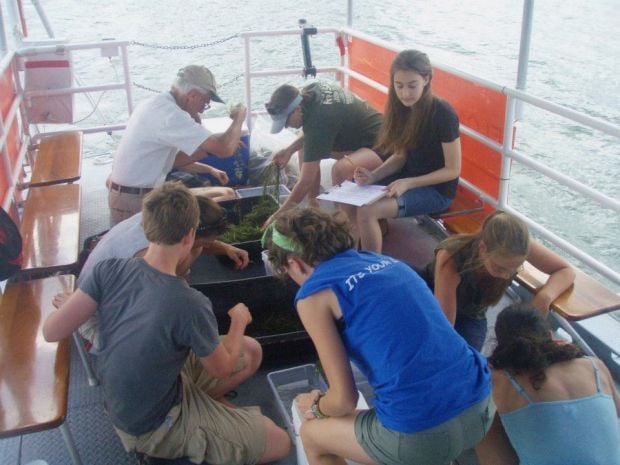Did you know that hydrilla was first discovered in the Cayuga Lake Inlet by one of our highschool summer interns in 2011?
Hydrilla is an extremely invasive plant species, which takes over waterways and makes them impassable for boats and an impossible place for other plants and animals to survive.
Originally brought to the United States as an aquarium plant because of its high tolerance for varied water conditions, hydrilla was released into rivers and lakes in the southern U.S. - quickly overtaking many waterways.

Hydrilla can be identified by its whorls of 5 to 8 leaves, by the serrated (or teethed) edges of those leaves, by the reddish color located along the stem, and by tubers that store nutrients at the end of the stem.
 |
| These are hydrilla tubers. |
Part of the struggle with controlling hydrilla is that it has multiple methods for reproduction, making it spread all the more easily. These methods include tubers, turions, seeds, and fragmentation. Tubers are produced at the end of underground stems (hydrilla has no roots). If you are having trouble picturing a hydrilla tuber, it might help to realize that potatoes are a type of tuber (and similarly, if you plant a potato it will grow more potatoes). Turions are basically dormant hydrilla buds and are located at the base of a whorl of leaves. While those two are the main methods of reproduction for the plant, fragmentation is perhaps the most dangerous. Spreading through fragmentation means that if a boat propeller cuts up a bunch of hydrilla plants, you end up with more individual hydrilla plants (hence the picture of the hydra-like hydrilla above, hydra being a dragon that grows more heads as each is cut off). And the last method of reproduction, seeds, is the least used and is mostly important for spreading over distances - it seems hydrilla seeds can be ingested by birds and carried to entirely new places.

This plant species spreads quickly. All it takes is one boat propeller or other a bird and a part of the plant (whether it be a tuber, turion, fragment, or seed), and hydrilla has moved to yet another body of water - in this way rapidly making its way across the country. The discovery of hydrilla in Cayuga Lake is particularly scary because we are connected to the Great Lakes via the Erie Canal and as such, there is a lot of boat traffic which could bring hydrilla into the Great Lakes (which have so far managed to keep hydrilla out of their long list of water quality issues).
 |
| 2012 hydrilla monitoring on Cayuga Lake. |
There are methods for controlling hydrilla on Cayuga Lake, however, and so far it has not been spread to the Great Lakes. We at Discover Cayuga Lake are working with Bob Johnson, a research scientist, monitoring the lake for hydrilla, using rake tosses along the shores to pull up and identify aquatic plants. Additionally, there is an air boat that goes along the shore by Stewart Park spraying herbicides into the shallow waters to try to control the spread there.

No comments:
Post a Comment